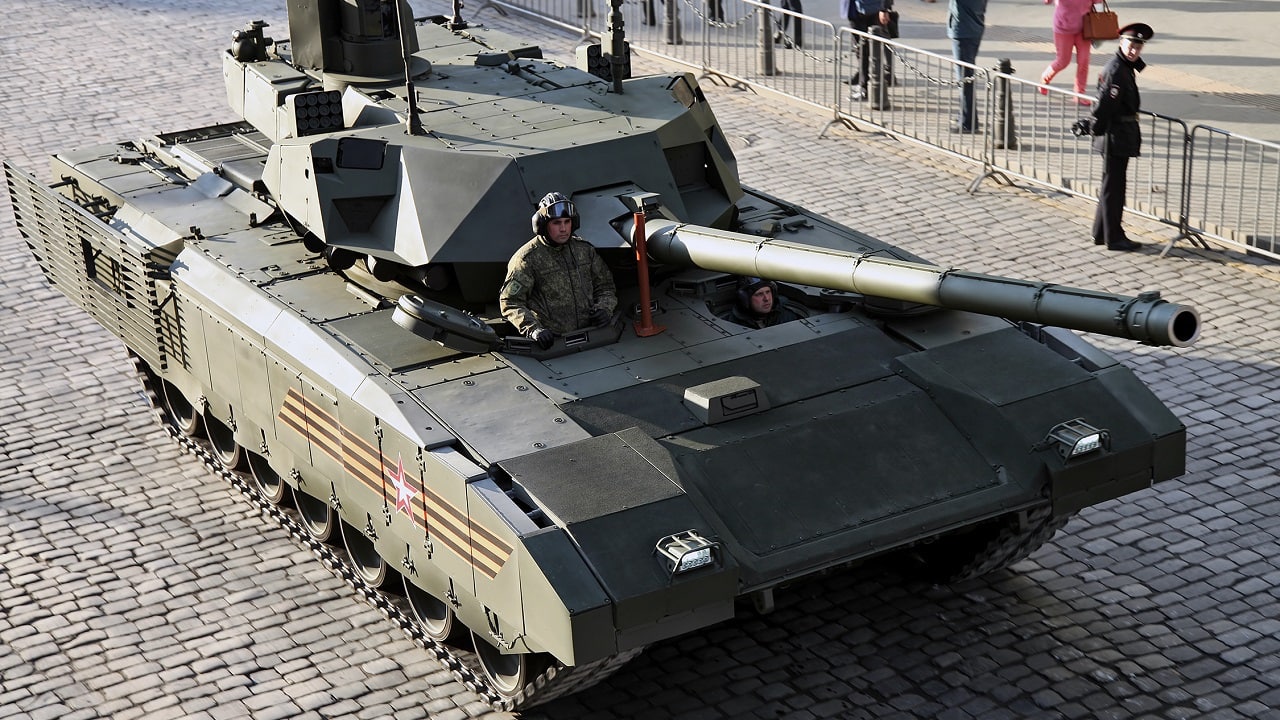What happened to Russia’s vaunted T-14 Armata tank?
This feat of engineering was supposed to transform armored maneuver warfare for Vladimir Putin’s forces.
(Subscribe to Our YouTube Channel Here. Check out More 19FortyFive Videos Here)
Instead, it looks to be over-rated and lacks the ability to make a difference on the battlefields of Ukraine. Why has this tank become a paper tiger?
It has enviable characteristics such as a robust auto-loading main gun, an unmanned turret, and a powerful turbocharged engine. But Russia has struggled to build these in numbers, and the tank has not dominated the enemy as once advertised.
What Are the Problems?
The T-14 is expensive at nearly $4 to 6 million each, and not easily replaced if it is blown up. In Ukraine, defenders have made mincemeat of Russian armor using shoulder-fired guided anti-tank missiles and conventional artillery fire. If a T-14 Armata gets damaged, there are no spare parts available. If it breaks down, maintenance crews are not trained to bring it back to life.
Too Heavy for Muddy Conflict Zones
The T-14 Armata is also difficult to transport because of its heavy weight of 10,600 pounds. It could get stuck in the mud this spring when the ground thaws. Russia is only making about 20 to 30 tanks of all variants per month. The Russian army is losing many more tanks each month than that rate, some have estimated the occupiers have lost around 3,000 tanks. This is a slow production rate brought on by international sanctions.
Armata: It Looks Good on Paper
When the T-14 Armata was introduced, there were reasons for Western militaries to fear it. It had in some cases better specs than the older base model M1A2 Abrams, German Leopard 2, and British Challenger 2. The T-14 has an unmanned remote weapons turret which increases survivability for the three-man crew. The autoloading 125mm smoothbore gun packs a wallop. There are 45 rounds on board. The cannon can also launch a laser-guided anti-tank missile. The fire control system is aided by thermal sights, a digital networking system, and advanced sensors to snoop out enemy tanks.
Crew Should Be Better Protected
The basic protection of the low silhouette tank is made up of modern steel armor and metal-ceramic plates. There is reactive armor on the sides, active and passive armor on the front, and slat armor on the rear. This configuration is supposed to protect the tank better than other vehicles in the Russian fleet, especially with its ability to thwart enemy anti-tank missiles, armor penetration, and sabot rounds with the new Afghanit protective system.
The gas turbine engine with an eight-speed automatic transmission puts out 1,500 horsepower and enables speeds of up to 55 miles per hour. The range of the T-14 is 310 miles.
Russia Originally Wanted at Least 2,000 T-14s
The Russians were so excited by the T-14 Armata since it was introduced in 2015, that they ordered 2,300 models by 2025. While estimates vary, the Russian army may have now only purchased 100 of the new tanks. A few have been seen on the battlefield in Ukraine, according to social media posts in October.
The T-14 may instead be set aside for export. The Russian military-industrial complex is more adept at building and modernizing T-72, T-80, and T-90 tanks. So, Ukraine is not the right war for the T-14. Russia is relying on legacy tanks that can be built quicker and more easily than the Armata. Plus, the Kremlin would be further shamed if its prized modern tank was destroyed by Ukrainian fire.
Another Humiliation in the Current War
Thus, the T-14 has been an embarrassment that began when one broke down during the May 9 Victory Day parade in Red Square in 2015. The program has been jinxed since then. The 19FortyFive will keep an eye on whether the T-14 further makes appearances in Ukraine. So far it appears that the T-14 will be an afterthought for a Russian army that needs cheaper tanks built fast on proven platforms, rather than overhyped experimental technology demonstrators for next-generation warfare.
Author Expertise and Experience: Serving as 19FortyFive’s Defense and National Security Editor, Dr. Brent M. Eastwood is the author of Humans, Machines, and Data: Future Trends in Warfare. He is an Emerging Threats expert and former U.S. Army Infantry officer. You can follow him on Twitter @BMEastwood. He holds a Ph.D. in Political Science and Foreign Policy/ International Relations.

